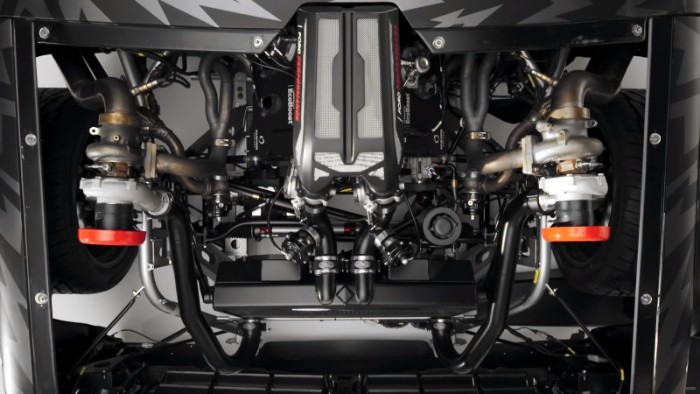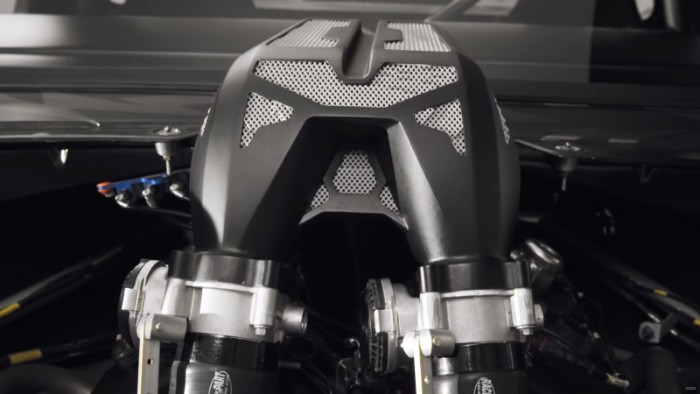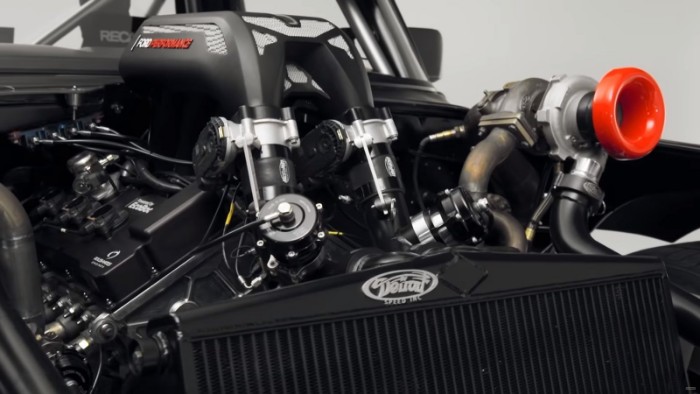A custom 1977 Ford F-150, dubbed the Hoonitruck, is the hero vehicle in Ken Block’s latest drift movie – Gymkhana Ten. Appearing last in the sequence, the Hoonitruck is seen performing jaw-dropping drifts with Ken Block firmly in control.
This is the most tricked out pick up truck we’ve ever seen and it makes use of some cutting edge technology. The Hoonigans enlisted the help of Detroit Speed and Ford Performance to realize the build. And they delivered.
One of the unique parts of this pickup truck is the 3D printed intake manifold. The crown of the build sits firmly on top of the 3.5-liter EcoBoost V6.

This engine has been used extensively in Ford’s product range. Most notably it’s featured in the F-150 Raptor and Ford GT. The Ford Racing program has done extensive R&D on the engine and eventually won the Le Mans race in 2016 and came in second in 2017.
These are very impressive achievements. However, the EcoBoost V6 in Ford GT only produces 647 horsepower. That’s way more than the average driver can handle but not nearly enough to send a huge pickup truck drifting.
To realize his Gymkhana movie, Ken Block needed more power out of his engine.
To get that power, Garret designed a set of custom twin turbochargers to provide a sustained boost. However, getting that compressed air to the cylinders efficiently proved an arduous task.
Queue in Ford Performance who designed a bespoke intake manifold specifically for the task. The interior structure of the part is so complex, that you can’t cast it or mill it out of a block.

The only way to produce the part was to rely on an emerging technology: metal 3D printing.
3D printing in plastic has become trivial. Anybody can purchase a printer and create objects in their bedroom. However, making things out of metal, even more so, structures working under heavy loads and high pressure is an entirely new science.
Ford Performance teamed up with their research partners at RWTH Aachen’s Digital Additive Production Institute in Germany.
The university specializes in additive manufacturing and have a partnership with Ford since 2013.
It took painstaking work and pushed the engineers, the software, and the hardware to the limits. The final part printed for 5 days straight. Ford claims it’s the largest 3D printed metal part that has been installed in a running vehicle.
The end result is an engine producing 914 hp and 700 lb/ft of torque. As far as we know, this is the most powerful version of the EcoBoost V6. It’s more than enough to send the Hoonitruck flying.

The only other car builder that boasts 3D printed parts is Bugatti, which are developing a new brake caliper for the Chiron.
HRE also unveiled their 3D printed titanium wheels a few months ago.
It’s exciting to see the technology making its way into car building. It’s still very expensive and too complicated to feature in mass-produced vehicles. However, additive manufacturing comes with a great set of benefits:
- You can 3D print structures that are otherwise impossible to manufacture
- The manufacturing process is less wasteful in terms of raw materials
- The geometry of each part can be optimized using computer algorithms. This allows you to create a strong part with less material, saving on weight.